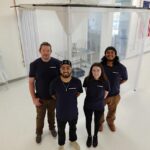
The National Aeronautics and Space Administration (NASA) had a previous flagship product (The Hubble Telescope) whose potency has left many in awe but its latest addition; the James Webb Space Telescope (JWST) may as well leave us spell-bound as it’s more than 100 times potent than its predecessor.
After about 31 years of Space exploration with the Hubble Telescope, NASA has launched a new flagship in the orbit, the JWST, a flagship as large the size of a tennis court, while being shaped like a spaceship out of Star Wars.
The JWST, having eclipsed its forerunner, the Hubble, can reveal in meticulous detail, galaxies just as they existed 13.5 billion years ago, at the very inception of the universe.
The old Telescope by NASA, Hubble was designed in such a way that it would capture only visible light, something humans can see with the normal eye. It allowed us gaze far into the universe, made us understand planet formation, gave us the opportunity to know the age of the universe but that may appear obsolete soon with the launch of a newer and more potent flagship.
Hubble has since 1990; 31 years ago taken more than 1.5 million photos that may have helped shape our understanding of the universe as far as we can see it, but JWST is far more effective with its ability to see in infrared, see past gas and dust clouds that float throughout space.
Most of the lights are made from infrared light and this begs for more discoveries, with the new technology making it possible to spot the farthest and most ancient galaxies the universe hides in its expanse.
One of the greatest distinctions between the telescopes is that Hubble can see wavelengths of light ranging from 90 to 2,500 nanometers, while JWST, can reach wavelengths of up to 600 to 28,500. It should be noted that the human eye can only see 380 to 700 nanometers.
The James Webb Space Telescope (JWST) do not just sport infrared sensors to give it an edge over its predecessor but has a gold-coated, 21.5-foot-wide mirror three times the size of Hubble’s mirror. This characteristic is very significant as the larger the area absorbing light, the more detail it can collect, an implication that the blurry specs known as galaxies photographed back in 2004 can be seen and studied in a much higher resolution.
With Hubble holding sway for about 15 years in the heavens, it may now be time for the next generation of space observation to step up and it is on the aegis of this that JWST is coming to the fore.
The new Telescope, armed with advanced infrared sensors and a gigantic mirror, is expected to continue snapping pictures of faraway galaxies for the next 5 to 10 years, and the first photograph is being expected in the summer.
Discover more from TechBooky
Subscribe to get the latest posts sent to your email.







